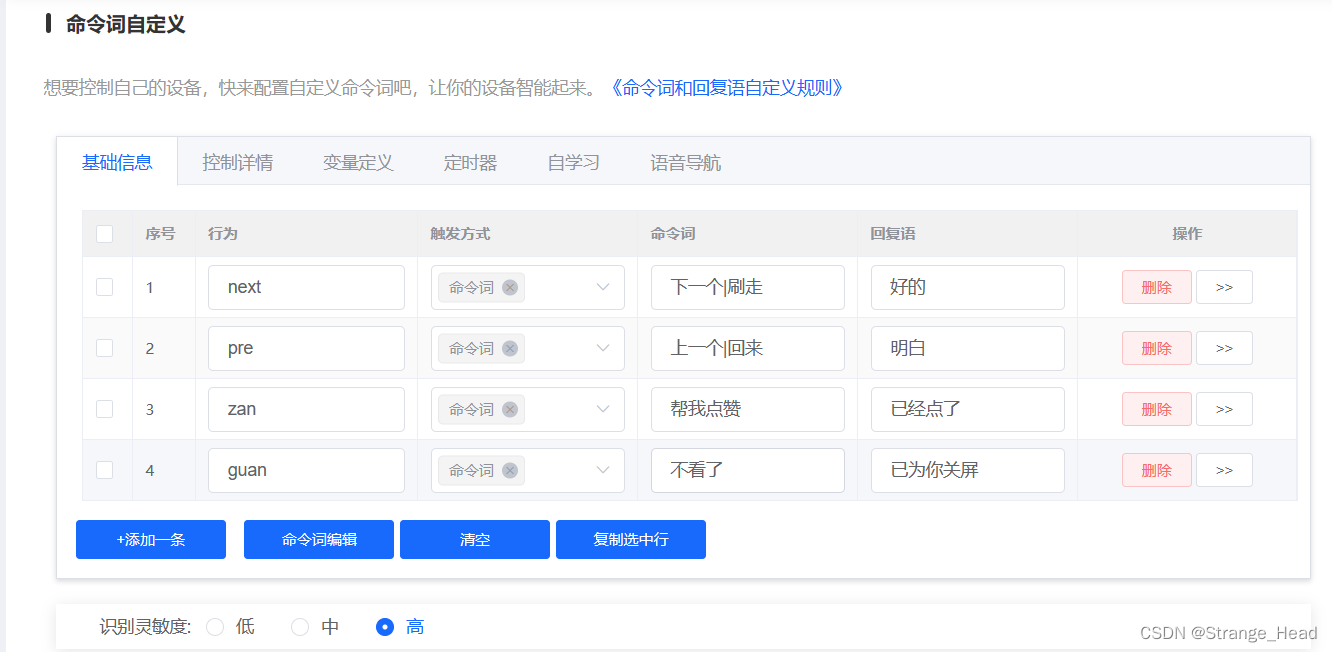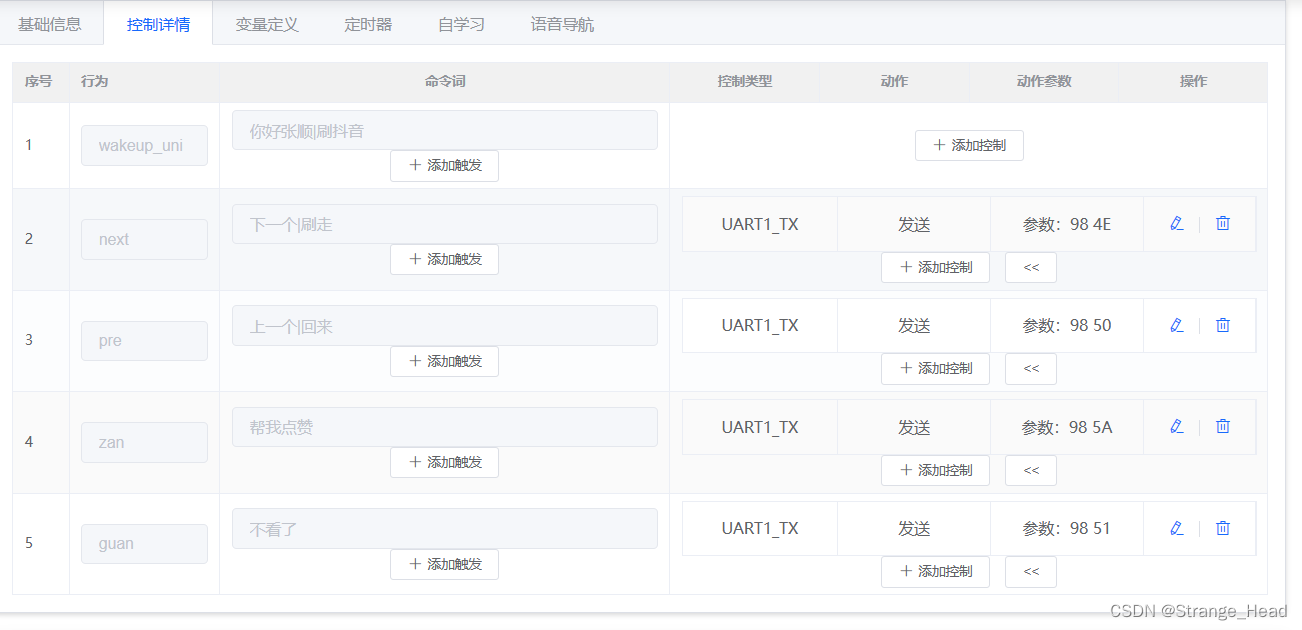文章目录
- 所需器材
- 装备操作
- SU-03T语音模块配置
- 代码(没有用wiring库,自己实现串口通信)
- 结束
所需器材
可以百度了解以下器材
orangepi-zero2全志开发板
su-03T语音识别模块
USB-TTL模块
一个安卓手机
一根可以传输的数据线
装备操作
安卓手机开启,开发者模式,并开启USB调试功能。
插入开发板,跳出什么就点允许就行(否则可能没有权限开发板无权访问手机系统)
SU-03T语音模块配置
进入网站:http://www.smartpi.cn/
这个模块其实进入网站点点点就可以完成,非常方便,但是没有什么技术含量
配置SU-03T模块
设置串口通信

设置唤醒词

设置命令触发

设置触发之后发送的命令

到此点击身材sdk,安静等待就可以了,搞好之后需要,将sdk上传至语音模块
将USB-TTL模块插入电脑,并将TX,RX与模块的TX,RX交叉相接。
将下载的sdk文件,打开,上传即可(图就不放了,较简单)
可以使用串口工具测试一下~
测试没问题将语音模块RX和TX接入开发板的RX,TX端口
代码(没有用wiring库,自己实现串口通信)
由于没有用wiring库所以多出俩个工具文件。当然也是用source insight分析源码cv编写,没写注释,将就看吧,这俩个文件,比较难啃,都是和linux内核打交道struct termios options;
uartTools.c
#include <stdio.h>
#include <stdlib.h>
#include <stdint.h>
#include <stdarg.h>
#include <string.h>
#include <termios.h>
#include <unistd.h>
#include <fcntl.h>
#include <sys/ioctl.h>
#include <sys/types.h>
#include <sys/stat.h>int myserialOpen (const char *device, const int baud)
{speed_t myBaud ;int status, fd ; struct termios options;switch (baud){case 9600: myBaud = B9600 ; break ;case 115200: myBaud = B115200 ; break ;}if ((fd = open (device, O_RDWR | O_NOCTTY | O_NDELAY | O_NONBLOCK)) == -1)return -1 ;fcntl (fd, F_SETFL, O_RDWR) ;// Get and modify current options:tcgetattr (fd, &options) ;cfmakeraw (&options) ;cfsetispeed (&options, myBaud) ;cfsetospeed (&options, myBaud) ;options.c_cflag |= (CLOCAL | CREAD) ;options.c_cflag &= ~PARENB ;options.c_cflag &= ~CSTOPB ;options.c_cflag &= ~CSIZE ; options.c_cflag |= CS8 ; //数据位8个options.c_lflag &= ~(ICANON | ECHO | ECHOE | ISIG) ;options.c_oflag &= ~OPOST ;options.c_cc [VMIN] = 0 ;options.c_cc [VTIME] = 100 ; // Ten seconds (100 deciseconds)tcsetattr (fd, TCSANOW, &options) ;ioctl (fd, TIOCMGET, &status);status |= TIOCM_DTR ;status |= TIOCM_RTS ;ioctl (fd, TIOCMSET, &status);usleep (10000) ; // 10mSreturn fd ;
}void myserialPutchar (const int fd, const unsigned char c)
{int ret;ret = write (fd, &c, 1) ;if (ret < 0)printf("Serial Putchar Error\n");
}void mySerialSendString(const int fd,const unsigned char *str)
{if(write(fd,str,strlen(str)) < 0){printf("Serial sendString Error\n");}
}int mySerialGetchar(const int fd, unsigned char *c)
{if(read(fd,c,1) !=1){return -1 ;}}int mySerialGetString(const int fd, unsigned char *str)
{if(read(fd,str,32) != 32){return -1;}
}uartTools.h
#ifndef _UART_TOOLS_H_
#define _UART_TOOLS_H_
int myserialOpen (const char *device, const int baud);
void myserialPutchar (const int fd, const unsigned char c);
void mySerialSendString(const int fd,const unsigned char *str);
int mySerialGetchar(const int fd, unsigned char *c);
int mySerialGetString(const int fd, unsigned char *str);#endif
uart.c
到这里就是简单的处理语音模块发来的命令了
#include <stdio.h>
#include <stdlib.h>
#include <stdint.h>
#include <stdarg.h>
#include <string.h>
#include <termios.h>
#include <unistd.h>
#include <fcntl.h>
#include <sys/ioctl.h>
#include <sys/types.h>
#include <sys/stat.h>
#include <pthread.h>#include "uartTools.h"int fd;void *recvHandler()
{char *recvBuf;recvBuf = (char *)malloc(sizeof(char)*32);if(recvBuf == NULL){printf("recvHandler malloc fail\n");}while(1){memset(recvBuf,'\0',strlen(recvBuf));mySerialGetchar(fd,recvBuf);switch(*recvBuf){case 'N':printf("next\n");system("adb shell input swipe 540 1300 540 500 100"); //adb 命令,模拟手机滑动屏幕break;case 'P':printf("pre\n");system("adb shell input swipe 540 500 540 1300 100");break;case 'Z':system("adb shell \"seq 2 | while read i;do input tap 350 1050 & input tap 350 1050 &sleep 0.2;done;\"");printf("zan\n");break;case 'Q':printf("quit\n");system("adb shell input keyevent 26");break;}}}int main(char argc, char **argv)
{char filename[32] = {'\0'};pthread_t recvPthread;if(argc < 2){printf("uage:%s /dev/ttyS?\n",argv[0]);return -1;}strcpy(filename,argv[1]);if((fd = myserialOpen(filename,115200)) == -1){printf("open %s error\n",filename);return -1;}pthread_create(&recvPthread,NULL,recvHandler,NULL);while(1){sleep(10);}return 0;
}结束
如有问题,欢迎提出,共同进步





)
UDP广播无效问题)

)
(分页查询)(网站反爬虫策略,需要在代码中添加合适的请求头User-Agent,否则response返回空))

![[k8s]helm使用](http://pic.xiahunao.cn/[k8s]helm使用)



)

)

